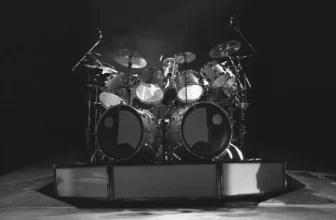How To Play Paradiddles with Ease


Drummers can be a pretty simple breed – it’s no great secret. We pick up two pieces of wood, and we hit things to make music. It’s hard to make that process sound complicated!
The way we name our equipment holds a certain straight forward-ness too: The kick drum? We kick it. The crash cymbal? It goes ‘crash!’. We like to keep it simple and more power to us!
This is only half the picture, though. We can also be a bit like the eponymous Will Hunting in the famous Robin Williams movie – the janitor of the music world, hiding our math genius to all but a few.
I prefer this angle, probably because it’s more flattering, but I’d swear it’s also more accurate! Like many of us, I know the joy of threading an elaborate fill through a piece of music while playing with a band – only to find that I’ve confused them, and they’re staring at me like I’ve made a mistake.
In the end, it doesn’t matter whether you see yourself as a Fred Flinstone-esque, primitive tub-thumper, or a high-brow jazz-fusion drummer who savors their drumming like a wine taster. All are welcome here.
And today we’re going to be talking about an exercise which can add a whole new dimension to our playing.
Today, we’re going to be looking at the paradiddle.
Abso-paradiddle-y!
If you’re a fan of The Simpsons, the term paradiddle may well put you in mind of Ned Flanders. It sounds like the sort of thing he’d enjoy saying.
The name is actually based on the paradiddle’s make-up of single and double strokes. The ‘para’ refers to the single stroke (R L), and the ‘diddle’ refers to the double stroke (R R).

You’ll find that there are double paradiddles, triple paradiddles, and paradiddle-diddles, to name but a few. I’m sure these names all have refined and civilized origins, but I sometimes think they sound like they were thought up over a few beers (probably not something Mr. Flanders would approve of)!
Great Name, But Why is the Paradiddle Useful?
Funny names aside, the paradiddle is an exceptional tool. It fits into a category of drum exercises known as ‘rudiments.’
There are many rudiments. Each one is designed to develop some areas of drumming ability: speed, stick control, dexterity, endurance, and so on. Rudiments can also be used as ‘vocabulary builders.’
To see what I mean, why not take a seat at your drums? Sit behind your kit for a moment and try to improvise. Play. Play anything!
Maybe you found that easy, but most of us don’t.
Many of us would love to improvise freely on our drums; to create whatever we’d like to make, spontaneously and without boundaries.
However, whenever we try, the same perplexing question rears its head: What the heck do we play? Where do we begin?
The rudiments give us ideas to springboard from, and blueprints to integrate into our playing so that we can create exciting and diverse phrases of music.
The paradiddle is a simple example of this, but it’s also really compelling. I’ve probably built the hype as much as I can, so let’s meet our new best friend now!
How to Play Your First Paradiddle
The paradiddle runs like this:

Be careful! Make sure you don’t speed up on the doubles (RR and LL). Keep those eighth notes consistent. Try starting this at 60bpm, and keep looping it around. You can gradually pick up the speed until you’ve got it flowing fast and even.
As discussed earlier: practicing these simple exercises will boost dexterity, speed, endurance, and stick control. It’ll make it easier to move with nimbleness and agility around the drum kit. This rudiment will directly help with some critical areas of drumming.
HOWEVER. There’s more: there are more tangible, directly-applicable uses for our paradiddle.
Orchestrating the Paradiddle
We can also use the paradiddle to help us to play more creative grooves and fills. To demonstrate this, take your right hand and place it over the hi-hat. Place your left hand over the snare drum. Try playing the paradiddle now, as notated below:

You might find it tricky at first because your brain will be trying to process two different sounds for the first time in this exercise.
That’s normal. Take it slow, and spend a few moments getting comfortable with it before moving on.
When you’re comfortable, skip to the notated exercise below, where we’ve now placed a kick drum on beat one and beat three.

You’ll hear that we have a nice groove developing now and that it’s probably a little more interesting than just playing a groove with straight eighths on the hi-hat.
Our straight eighth hi-hat grooves are still perfect for a vast number of playing situations, but now we have something a little different in our toolkit for when we need it.
Here are two more examples of a paradiddle-based groove, where the kick drums are placed on different beats in the bar.
Notice how different these grooves sound with each placement of the kick:

Don’t forget to take all these slowly if you’re finding them tricky! No one gets a medal for playing a drum groove fast on their first attempt. If you do start too quickly, you’ll become more and more frustrated with each mistake, and the whole thing will collapse before you’ve even started. Take it slow, and you’ll find you nail it way quicker than you otherwise would have done.
Injecting Some Extra Groove
If you want to be exceptionally slick, we can make all of the snare drum notes into ghost strokes apart from the snare drums on the two and four.
In case you’re unaware, a ghost stroke is an extremely cool name for an extremely quiet note.
We play a ghost stroke by placing the stick close to the drum head and playing it gently. We’ll need a separate article to talk about them in any great depth, so don’t sweat it too much if you find them difficult at the moment.
You can always leave them for now, and add them later when you’re a bit more familiar with them. Ghost notes sound great when added, though!
You’ll see the ghost strokes marked out in brackets in the groove below:

By adding these ghost strokes, we make our groove sound a little less frantic, we add a little more shape, and I think it flows a little more nicely. But as we’ve talked about in other articles, each groove has its place, and there’s no hard rule about using ghost strokes or not using them.
One More Groove Idea
I’ll leave you to experiment with your ideas soon, but here’s one more groove we can try. Now, we’ve placed the paradiddle onto the ride cymbal and the hi-hat.
The snare is still played on the two and the four, pictured below:

Wait, Fill Me In Some More!
Okay, I did say that I would leave you to experiment after the last groove, but it seemed silly to avoid talking about fills—and I couldn’t refuse an opportunity to use a pun in the heading!
What about our fills then; are paradiddles irrelevant to these? Of course not! We can use our paradiddle to create all kinds of great fills – not least, some cool linear ones.
A linear fill is usually described as a fill which uses one drum/cymbal at a time. Linear fills are popular in gospel, pop, hip-hop, R’n’B, and similar styles.
It’s another topic that needs its own article to be better understood, but it’s unnecessary to know everything about them to enjoy playing one or two.
Here are two to get you started:


Wrapping It Up
So, how can we be creative in our grooves, fills, and drum solos? There’s more than one way, for sure. But drum rudiments give us helpful blueprints.
We can think of them as Lego bricks; we can place them next to each other, on top of each other, and move them around at will, to create some great musical ideas.
The paradiddle is one such rudiment. Yes, it can be used as a stand-alone snare drum exercise to build stick control, dexterity, speed, and endurance. But it can also be used – extensively – to create exciting grooves and fills.
As with anything, the more comfortable you are with paradiddles, the more options become available to you. We can extend the paradiddle, invert the paradiddle, and mix other rudiments in too. Those will come later, though, and perhaps we’ll leave them for another article.
It’s no exaggeration to say that the paradiddle is easily my favorite rudiment. I don’t usually loop it ‘ad infinitum’ (although that’s certainly an option). Instead, I tend to use it to add spice and variety to my grooves and fills whenever the occasion calls for it.
Take a look at the music notated in this article.
Work on it over a week or two, and get it into your system. It’ll take you on a long journey of creativity, which will be super productive and extremely fun.
And if – by chance – you should bump into good old Ned Flanders in your town or city, ask him if he’s heard of them – I imagine that’ll be productive and fun too!

About the Author
Chris Witherall is a pro drummer, producer and songwriter from London, England. He loves talking about music, and helping people to reach their music goals.




